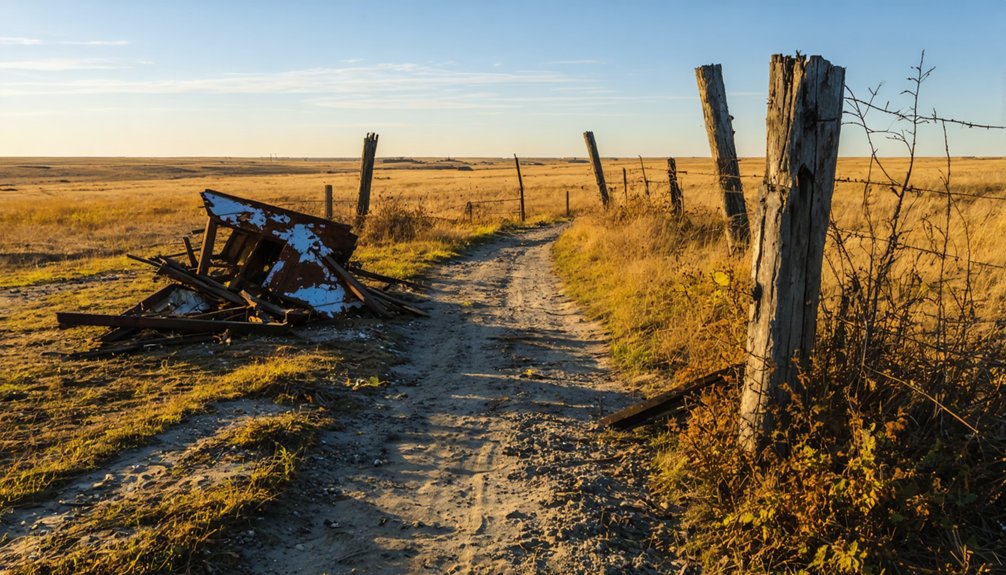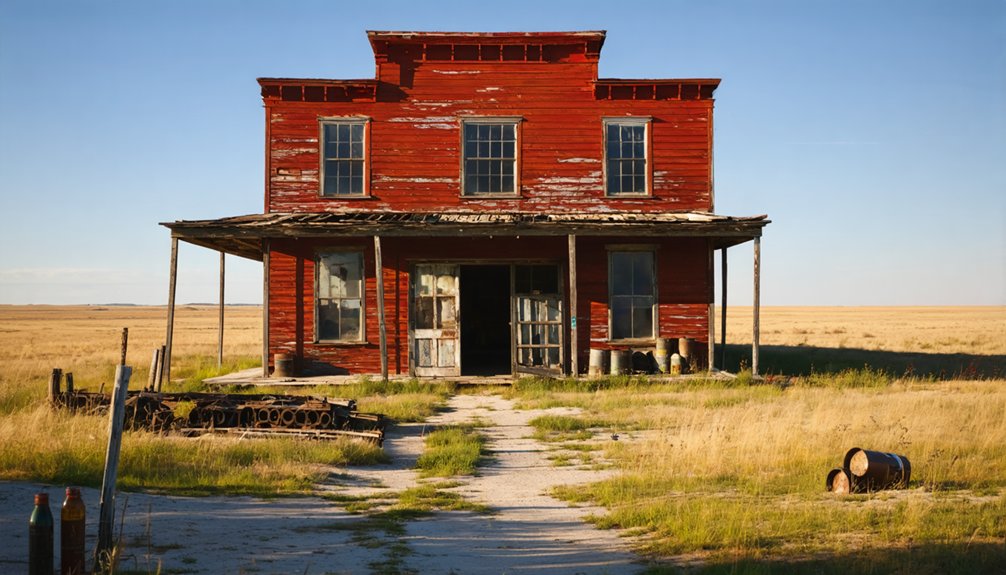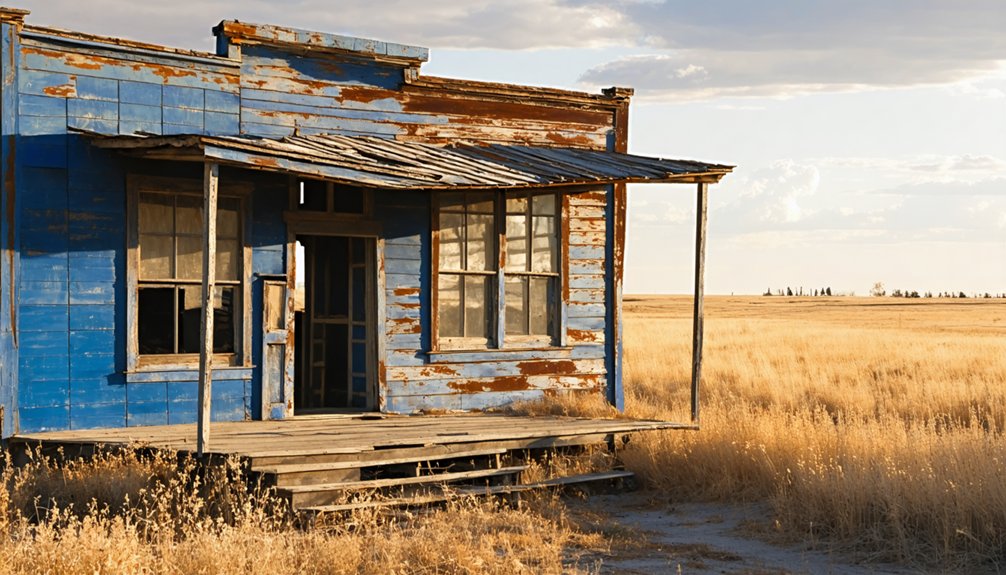You’ll find South Bend among South Dakota’s forgotten ghost towns, originally established during the Black Hills gold rush of the late 1800s. The settlement transformed in the 1920s when oil discoveries brought impressive gushers and rapid development. While the town thrived briefly through fur trading, mining, and oil production, its eventual decline left only scattered remnants. Today, this privately-owned site requires permission to visit, though its fascinating story of boom-and-bust frontier life beckons exploration.
Key Takeaways
- South Bend was established during the Black Hills gold rush and later experienced a second boom with oil discovery in the 1920s.
- The ghost town is entirely located on private property, requiring explicit landowner permission to visit.
- Physical remains are minimal, with most structures reduced to foundations and debris scattered across the former settlement site.
- The town’s economy was driven by mining, oil production, and railroad connections before declining when resources were depleted.
- Visitors must exercise caution due to hazards including unstable structures, hidden wells, and uneven terrain throughout the site.
The Origins of a Frontier Settlement
While the Black Hills gold rush spurred the establishment of numerous frontier settlements in South Dakota during the late 19th century, South Bend emerged as one of many towns that dotted the region’s expanding mining landscape.
The settlement dynamics followed a familiar pattern: prospectors and miners would establish camps near promising sites, while merchants and traders quickly set up shops to serve the growing population. Like other settlements in the region, land companies owned by railroads played a major role in developing the area.
You’ll find that South Bend’s location was strategically chosen near transportation routes and water sources, typical of frontier settlements that needed to overcome harsh frontier challenges. Similar to the Concord stagecoaches that serviced other Black Hills communities, regular transportation helped sustain the town’s development.
Like many of its neighboring communities, the town quickly developed essential infrastructure – including a post office and basic amenities – to support the miners and their families who’d ventured west seeking their fortunes in the region’s precious metals.
Life in Early South Bend
As pioneers established their roots in early South Bend, family life centered around Pierre Navarre’s 1820 log cabin, which became a model for settler housing in the region.
Frontier families like Navarre’s, who married Potawatomi woman Angelique Kechoueckquay, fostered cultural exchange through intermarriage and trade relationships.
Cultural bonds between settlers and Potawatomi tribes grew stronger through marriage alliances and trading partnerships in frontier South Bend.
Daily life revolved around domestic activities essential for survival: fur trapping, maple sugar harvesting, and basket making.
You’d find social dynamics shaped by shared experiences along Native American trails and waterways, where community identity grew through cooperation and mutual support.
Economic diversity flourished as settlers balanced traditional trades with agriculture, following seasonal patterns. The rise of buffalo hide trade in the 1830s provided new economic opportunities as beaver pelts declined in value.
American Fur Company agents like Navarre established vital trading networks that connected the frontier settlement to larger markets.
After death, burial traditions tied families to local institutions, as evidenced by Navarre’s final resting place in Cedar Grove Cemetery at Notre Dame.
Economic Rise and Fall
The discovery of oil in the early 1920s transformed South Bend from a modest frontier settlement into a booming economic powerhouse.
Oil wells reaching depths of 1,350 to 4,250 feet produced impressive gushers, fueling rapid development of water systems, schools, hotels, and even gambling venues.
Like South Dakota’s ghost town tourism, visitors today can explore the remnants of this once-thriving community.
The town’s economic diversification included casing head gasoline plants and manufacturing, while the Wichita Falls and Southern railroad connected South Bend to regional markets.
The Stovall property well also became a popular resort destination, providing hot mineral water to visitors.
But you can’t sustain a boom forever.
As oil production declined and wells became less productive, the town’s community resilience was tested.
The railroad’s removal over 50 years ago dealt a devastating blow, severing essential supply lines.
Without transportation infrastructure and depleted resources, businesses shuttered, people moved away, and South Bend’s once-vibrant economy crumbled into ghost town status.
Mining’s Impact on South Bend
Mining operations near South Bend evolved from simple placer mining in streambeds to sophisticated hard rock extraction methods that shaped the region’s development.
You’d have seen the rapid transformation as mining technology advanced from basic hand-operated equipment to complex chlorination and cyanide processing plants that could extract gold from low-grade ore.
Square set timbering methods were implemented to support mine roofs and ensure safer extraction operations.
While these technological advances brought economic prosperity, they’ve left lasting environmental consequences.
The use of cyanide in gold leaching contaminated local waterways, and extensive excavation permanently altered the landscape.
Like many settlements following the Custer Expedition of 1874, South Bend experienced an influx of prospectors seeking their fortunes in the Black Hills.
You’ll find evidence of this mining legacy in the waste and tailings that required ongoing monitoring under South Dakota’s mining laws.
The boom-and-bust cycle you’d expect from mining towns played out here, creating periods of rapid growth followed by decline as resources depleted.
Notable Structures and Landmarks
While searching for notable structures in South Bend today, you’ll find little remaining evidence of its brief existence as a Black Hills mining settlement.
Historical records don’t document any specific notable buildings that have endured the passage of time, and there’s no confirmed cemetery or preserved landmarks to mark the town’s historical significance.
Like most abandoned towns, South Bend demonstrates the respect for property needed when visiting such historical sites.
You won’t find maintained visitor facilities or interpretive displays common to other preserved ghost towns in the region.
Similar to Capa’s collapsed church, the site likely contains only scattered foundations, if anything at all, having possibly reverted to pastureland.
Unlike more famous Black Hills ghost towns that maintain tourist-friendly ruins, South Bend’s physical remains have largely vanished, leaving its exact location unmarked and its structural heritage largely forgotten.
Stories From Former Residents
Through oral histories and documented accounts, former South Bend residents painted a vivid picture of frontier life’s harsh realities. Their stories reveal a town marked by transient populations, including the tale of “Calamity,” who died at the Calloway Hotel from bowel inflammation.
Pioneer struggles were evident in countless anecdotes of illness, limited medical care, and frequent relocations between settlements.
You’ll find tales of tight-knit communities bonded through shared hardships, though social tensions often bubbled beneath the surface. Some residents, previously run out of Deadwood, sought fresh starts in nearby towns like Terry.
The railroad’s presence shaped much of the social fabric, bringing both prosperity and problems – from rowdy saloon culture to law enforcement challenges that tested the community’s resilience.
Current Site Conditions and Access

You’ll need to respect private property restrictions if you want to explore South Bend, as the ghost town sits on land requiring permission to access.
The remaining physical structures have deteriorated considerably over time, with most buildings now reduced to foundations, scattered debris, and occasional wall segments still standing.
When visiting, watch for hazards like unstable structures, uneven ground, and exposed materials while bringing necessary safety gear and navigation tools since no maintained paths or facilities exist.
Private Property Restrictions
Because South Bend resides entirely on private property, visitors must obtain explicit permission from the current landowners before accessing any part of the ghost town site.
South Dakota’s strong property rights laws protect landowners from unauthorized entry, with both civil and criminal penalties possible for trespassing.
You’ll need to respect posted “No Trespassing” signs and understand that South Dakota law strictly enforces private property protections.
The legal implications of unauthorized access are serious, as the state maintains some of the nation’s strongest restrictions on property rights.
If you’re interested in visiting or researching South Bend, you’ll need to locate and contact the current owners to arrange permission.
Remember that adverse possession laws require 20 years of continuous occupation, so temporary visits don’t establish any access rights.
Physical Remains Today
While extensive research has been conducted on South Dakota’s ghost towns, South Bend’s physical remains are poorly documented in historical records.
Unlike well-known ghost towns such as Swett and Central City, South Bend’s site visibility remains uncertain, with no confirmed structures or ruins marking its location. The archaeological significance of the area can’t be determined due to limited historical documentation and the absence of verified artifacts.
You’ll find that the surrounding region features the dramatic landscapes of the Black Hills and Sylvan Lake, but there’s no concrete evidence linking these natural landmarks to South Bend’s specific location.
The area’s varying environmental conditions and soil moisture changes may have impacted any remaining physical evidence of the settlement over time.
Site Safety Considerations
Although South Bend’s exact location remains unclear, potential visitors should exercise extreme caution when exploring any suspected ghost town sites in the area.
You’ll likely encounter numerous site hazards including unstable structures, hidden wells, exposed metal, and uneven terrain. Since many ghost towns sit on private property, you’ll need permission to access these sites legally.
Proper visitor preparedness is essential for your safety. You should bring navigation tools, first aid supplies, and plenty of water, as cell service is unreliable in rural South Dakota.
Be aware that weather conditions can change rapidly, and wildlife encounters are possible. Always inform someone of your travel plans before exploring.
Watch for warning signs and respect property boundaries, as trespassing can result in fines or prosecution.
Preserving South Bend’s Legacy

You’ll find South Bend’s historical records scattered across various archives and historical societies, reflecting the town’s brief but significant role in South Dakota’s pioneer settlement period.
While most physical traces of the town have vanished, the preservation of documents, photographs, and oral histories helps paint a picture of life in this early Black Hills community.
The site’s remote location and historical significance could make it an attractive destination for heritage tourism, particularly if integrated into broader regional ghost town tours and educational programs.
Historical Records Matter
When exploring ghost towns like South Bend, historical records serve as the foundation for understanding and preserving its legacy. You’ll find that these documents, maintained by the South Dakota Historical Society and local archives, reveal essential details about the town’s establishment, development, and eventual abandonment.
Through photographs, maps, and written accounts, you’re able to piece together South Bend’s historical significance within the Black Hills region.
Record preservation faces ongoing challenges, from fragmented documentation to limited firsthand accounts. Yet these materials prove invaluable for researchers and descendants seeking to connect with their heritage.
Future Tourism Potential
As South Bend stands poised for a tourism renaissance, strategic development plans focus on preserving its authentic ghost town character while creating sustainable visitor experiences.
You’ll discover a thoughtfully designed tourism development initiative that balances historical preservation with modern amenities.
- You can explore restored historic buildings featuring interactive exhibits and interpretive signage that bring South Bend’s compelling story to life.
- You’ll benefit from improved accessibility through new roads and visitor facilities, including convenient parking and restrooms.
- You’re invited to participate in guided tours and cultural events that enhance visitor engagement while celebrating local heritage.
- You’re supporting sustainable tourism practices that protect both the historic structures and surrounding environment, ensuring South Bend’s legacy for future generations.
Frequently Asked Questions
Were Any Famous Outlaws or Historical Figures Known to Visit South Bend?
Wind-swept plains hold no clear outlaw legends or documented historical visits to this location. You won’t find verified accounts of famous figures stopping by this small frontier settlement.
What Native American Tribes Originally Inhabited the South Bend Area?
You’ll find the Sicangu Lakota and other Sioux tribes were the primary inhabitants of this area, with their Native heritage deeply connected to the Missouri River’s fertile lands and grasslands.
Did Any Major Accidents or Disasters Occur in South Bend’s Mines?
Picture raging floodwaters tearing through the gulch – that’s your major disaster. While mining accidents plagued the region, you won’t find specific disaster reports from South Bend’s mines beyond the devastating 1883 flood.
Were There Any Documented Paranormal Activities or Ghost Sightings?
You won’t find verified ghost encounters or spectral sightings in official records. While visitors sometimes report vague atmospheric experiences common to abandoned towns, there’s no documented paranormal activity specific to this location.
How Did South Bend Get Its Name?
You’ll find the name origin likely stems from a southern bend in a nearby river, though historical records don’t document this specifically. It’s consistent with regional naming patterns of early settlements.
References
- https://www.youtube.com/watch?v=Glucs_Rq8Xs
- https://www.sdpb.org/rural-life-and-history/2023-08-21/some-black-hills-ghost-towns-and-their-origins
- https://www.youtube.com/watch?v=_0WNYsFLSLA
- https://icatchshadows.com/okaton-and-cottonwood-a-photographic-visit-to-two-south-dakota-ghost-towns/
- https://en.wikipedia.org/wiki/List_of_ghost_towns_in_South_Dakota
- https://www.youtube.com/watch?v=De3wGn9KDkg
- https://aberdeenmag.com/2019/01/the-ghost-towns-of-brown-county/
- https://www.tripadvisor.com/Attraction_Review-g54726-d622050-Reviews-South_Dakota_s_Original_1880_Town-Murdo_South_Dakota.html
- https://www.1880town.com
- https://www.sdhspress.com/journal/south-dakota-history-2-2/some-black-hills-ghost-towns-and-their-origins/vol-02-no-2-some-black-hills-ghost-towns-and-their-origins.pdf



